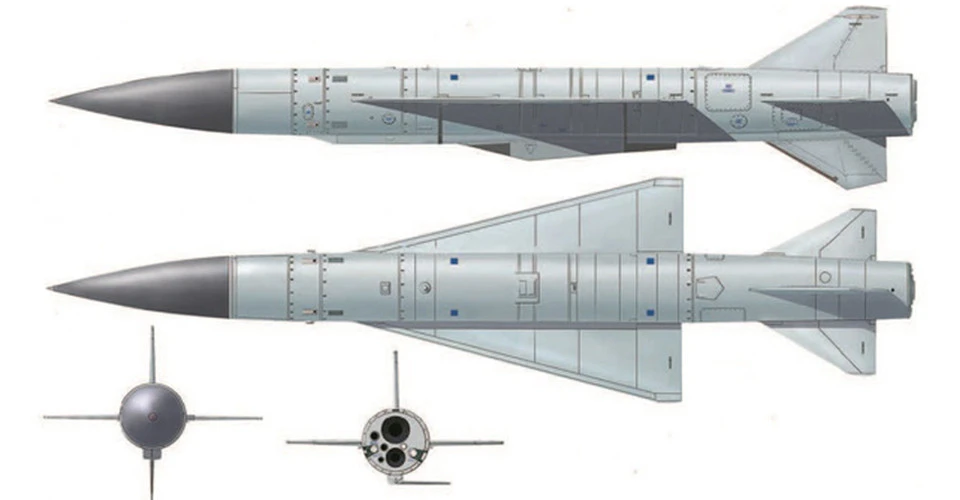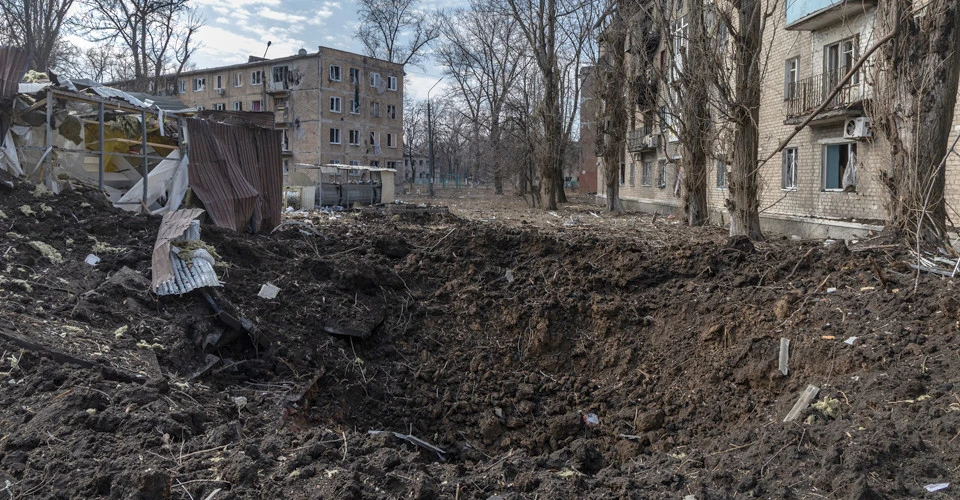
Kh-22 missile: all about weapons Russia uses for terrorist attacks
The use of the Kh-22 missile by Russian forces is closely linked to war crimes. It was this weapon that was used in the attack on the Armstor shopping center in Kremenchuk, residential buildings in Dnipro and Serhiivka, shopping center in Odesa, and other attacks
Espreso tells about the technical characteristics of the Kh-22, what the missile was actually designed for, and why it is called "blind".
Kh-22 missile: development and technical characteristics
The Kh-22 Burya (Storm - ed.) is a Soviet supersonic long-range air-to-ground anti-ship missile. Development began in 1958, the first launch took place in 1963, and the Kh-22 was put into service in the late 1960s and 1970s. The missile was designed to destroy aircraft carriers with an explosive or nuclear warhead.
The missile is launched from supersonic Tu-22 and Tu-22M strategic bombers. Together, the missile and the aircraft form the K-22 aviation missile system. The Kh-22 missile itself weighs up to 6 tons, and its warhead reaches a ton.

Main characteristics of the Kh-22 Burya (NATO reporting name AS-4 'Kitchen')
- Length - 11.65 m
- Width - 1.23 m
- Diameter - 92 cm
- Altitude of operation - 10 km
- Range - up to 300 km
- Speed - 3.5 mach (up to 4000 km/h)
- Weight - 5820 kg
- Warhead weight - 950 kg
As for the cost of the missile, Forbes Ukraine magazine, trying to calculate the cost of ammunition fired by Russia at Ukrainian territory, determined the price of the Kh-22 at 1 million US dollars. However, such a calculation is quite conditional, according to the Defense Express article. The production of the Kh-22 was completed in the 1980s and was carried out in the planned economy of the USSR. Moreover, to determine the cost of missiles, it is necessary to convert Soviet rubles into dollars, with an error for inflation. Besides, the Soviet Union never announced even the approximate cost of the Kh-22.
In any case, the Burya is a much cheaper consumable for Russia than the Kalibr or Iskander. Therefore, the use of the Kh-22 to attack Ukraine primarily indicates that the aggressors lack higher-class missiles, military observers are convinced.
"Before the war began, the Soviet Kh-22 cruise missiles, which are complex and dangerous to operate, were kept in Russian storage warehouses. Although formally they remained in service with the Russian Armed Forces. The exact number of Kh-22 missiles at their disposal is unknown for obvious reasons. But the very fact of using such outdated cruise missiles may indicate that they are really running out of Iskander and Kalibr missiles, and it seems impossible for the Russians themselves to restore the stocks of these missiles due to Western sanctions," the article said. Experts from the International Institute for Strategic Studies (IISS) also emphasized that the massive use of the Kh-22 missiles to strike ground targets shows that Russia wants to keep the precision missiles in case of emergency.
Kh-22 and war crimes in Ukraine
The K-22 missile system with Kh-22 missiles was not used by the invading Russian forces in the Russian-Ukrainian war for its intended purpose (destruction of surface targets). However, a few months after the start of the large-scale war, the first reports of the use of Kh-22 missiles to fire at land targets appeared. In particular, in May 2022, Commander-in-Chief of the Ukrainian Armed Forces Valerii Zaluzhnyi informed his American partners that Russia was massively using supersonic anti-ship missiles. He noted that they were firing 10-14 Kh-22 cruise missiles at civilian infrastructure every day.
This information was also confirmed by British intelligence. They emphasized that the use of these missiles to attack ground targets with conventional warheads cannot be accurate and leads to great destruction and casualties among civilians. Indeed, there have been many civilian casualties due to attacks with Kh-22 missiles.

For example, on May 9, 2022, Russian troops fired Burya missiles at warehouses in Odesa and the Riviera shopping center in the village of Fontanka. At least one person was killed and five were injured.
On the night of June 27, 2022, the Russian military launched a missile attack on a residential area in the village of Mayaky in Odesa region, damaging 65 private houses. Eight civilians, including two three-year-old twins, sustained multiple injuries. On the same day, a bloody terrorist attack was carried out in Kremenchuk, Poltava region, when Russia struck the Amstor shopping center with Kh-22 missiles. At the time of the attack, there were up to a thousand people in the shopping center. The center was completely destroyed as a result of the strike and fire. At least 21 people were killed.
18 people (including 2 children) were killed in the attack on the resort village of Serhiivka in Odesa region. On July 1, 2022, Russian troops fired Kh-22 missiles at an apartment building and two recreation centers. More than 30 people were injured.
The most bloody terrorist attack using the Burya missiles was carried out by the Russian troops on January 14, 2023. A missile fired from the Kursk region hit a high-rise building in Dnipro. 46 people died under the rubble of the destroyed building, including 6 children.
A "blind" missile for terrorist attacks
Any attack on populated areas with Kh-22 missiles can be qualified as terrorism, experts emphasize.
"If it was a Kh-22 missile, it could hit anywhere. These are missiles from the early 1950s, they are very outdated and can hit with a deviation of up to 1 km. The Russians could have aimed at any place in Kremenchuk and hit the shopping center. In fact, this is terrorism. The use of such weapons in cities and residential areas means a simple desire to kill people," noted military analyst Mykhailo Samus.
Thus, during the attack on the Amstor shopping center, another missile almost hit the Kredmash plant in Kremenchuk. The distance between the two facilities is about a kilometer.
Serhiy Zgurets, director of the information and consulting company Defense Express, also calls the attack with Kh-22 missiles an act of state terrorism. In an analytical piece on the Espreso website, he calls these missiles "blind".
"These missiles have homing heads that are relocatable, and which are able to capture only such radio-contrast targets as a group of buildings or individual bridges. So this accuracy is absolutely low," Zgurets writes.
Thus, on May 20, 2022, a Kh-22 cruise missile hit the city's Palace of Culture in Lozova, Kharkiv region. Seven people were injured, the youngest of whom was 11 years old. Experts say that the missile could have hit the building because it is the most radio contrasting of all the surrounding buildings, standing apart from the others and near a large park. While the largest object in the sea that the homing head captures is most likely an aircraft carrier, a missile in a city can choose any target.
There is also a modernization of the Kh-22 without a radar homing head, where only the inertial guidance system is responsible for guidance.
"If these homing heads are not used, and the missile flies only with the help of the inertial guidance system, the square it must hit is 10 km. This means that it is impossible to hit any object that is chosen as a target with such accuracy. This means that this missile is flying at a range of 500 km, and actually hits what its homing head will pick up, which sees only a group of objects, a group of buildings on the ground. Or if it is flying by coordinates, it hits a target that falls into this square or circle, 10 by 10 km," Zgurets writes.
Defense Express analysts believe that attacks on cities with an accuracy of up to 10 km cannot be qualified otherwise as terrorism.
These are indeed missiles that are used for terrorist attacks, as demonstrated by the Russian Federation. By the way, this missile is not easy to destroy, because when it descends from an airplane, it gains an altitude of 22 km, accelerates to a speed of 3-4 mach, and when it is 60 km away from the target, it begins to dive at the target at a sufficiently high speed and hits the object that the homing head sees.
This missile has the largest warhead compared to other missiles used by Russia today. The weight of the warhead of the Kh-22 missile is 1 ton. That is, if we see that such a blind missile hit the shopping center, we have consequences: about 1 ton of explosive was detonated. This caused the gas cylinders that were in the shopping center or other structural elements to ignite, which caused such a large fire. So, the use of these Kh-22 cruise missiles, which are actually absolutely blind in terms of military missions, is only a sign that Russia is trying to intimidate the Ukrainian population with such powerful missile strikes, and on the other hand, it suggests that this is an act of state terrorism, because these missiles are indiscriminate weapons.
"Hitting cities with Kh-22 missiles is a direct indication of Russia's desire to kill as many civilians as possible. The radar guidance system of these missiles is so primitive that it can only pick up an object such as "individual industrial buildings" against the background of the ground. In other words, even the USSR realized that the real effectiveness of the Kh-22 for striking cities, from a military point of view, was close to zero. That is why the ideology of their use for the Russian Federation should now be considered not from the point of view of military logic, but of terrorists. Because even if the missile did not destroy the planned military or industrial target, but killed civilians, it is still a success for the Kremlin," the article says.
By the way, the proceedings regarding Russian attacks with Kh-22 missiles on civilian targets in Dnipro, Kremenchuk, and Odesa region have been merged into one criminal case. Ukraine's Prosecutor General Andriy Kostin promised to "find everyone involved in these events."
How to deal with Kh-22 missiles
In March 2023, the spokesperson for the Ukrainian Air Force, Yuriy Ihnat, named the Kh-22 among the missiles that Ukrainian air defense cannot shoot down.
"When a missile is flying at such a high speed and enters the area of an anti-aircraft missile system, Ukraine's S-300 combat crew, for example, has only up to 40 seconds to detect it with the observation radar, directly capture it with the sub-surface radar and launch the missile. This time is physically insufficient for the operators of the outdated Soviet complex to successfully complete such a task," the spokesman explained.
According to him, none of the more than 120 Kh-22 missiles that had been launched since the beginning of the full-scale aggression had been shot down.
The most effective means of countering Kh-22 missiles is to shoot down the carriers themselves with fighter aircraft. To do this, the Ukrainian Air Force needs long-range air-to-air missiles and modern aircraft. If the Russian Tu-22M3s were to approach, they would come under fire from fighter jets and air defense systems of Ukrainian forces.
Ukraine's getting of American Patriot air defense systems contributed to the fight against the "blind" missiles. Ukrainian Air Force Commander Mykola Oleshchuk emphasized that defense against the Kh-22 is one of the main tasks of the Patriot.
- News











































